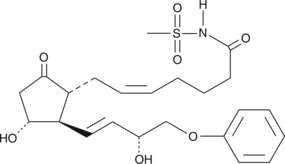Chemicals
Showing 36901–37050 of 41137 results
-
Sulfinpyrazone is a uricosuric agent that competitively inhibits uric acid (Item No. 16219) reabsorption in kidney proximal tubules, which is a key mechanism targeted in the treatment of gout.{28606,28995} It can also inhibit degranulation of platelets, reducing the release of ADP and thromboxane and diminishing platelet aggregation.{28994}
Brand:CaymanSKU:-Available on backorder
Sulfisoxazole is a sulfonamide antibiotic and nonpeptide endothelin (ET) receptor antagonist (IC50s = 0.6 and 22 μM for the ETA and ETB receptors, respectively).{47039,47040} It inhibits the growth of Gram-positive and Gram-negative bacteria in vitro, including S. pneumoniae, B. subtilis, S. epidermidis, E. coli, and K. pneumoniae (MICs = 1.95, 0.98, 7.81, 62.5, and 7.81 μg/mL, respectively).{47041} Sulfisoxazole inhibits phosphoinositide turnover stimulated by endothelin-1 (ET-1; Item No. 24127) in TE671 cells. It inhibits ET-induced contraction of rat pulmonary artery rings ex vivo when used at concentrations of 0.1 and 1 mM.{47040} Sulfisoxazole (1,000 mg/kg per day) reduces atrial natriuretic peptide levels in myocytes and plasma and increases survival in a rat model of pulmonary hypertension induced by monocrotaline (MCT; Item No. 16666) as well as blocks MCT-induced increases in pulmonary artery blood pressure when administered at doses of 300 and 1,000 mg/kg.
Brand:CaymanSKU:25980 - 1 gAvailable on backorder
Sulfisoxazole is a sulfonamide antibiotic and nonpeptide endothelin (ET) receptor antagonist (IC50s = 0.6 and 22 μM for the ETA and ETB receptors, respectively).{47039,47040} It inhibits the growth of Gram-positive and Gram-negative bacteria in vitro, including S. pneumoniae, B. subtilis, S. epidermidis, E. coli, and K. pneumoniae (MICs = 1.95, 0.98, 7.81, 62.5, and 7.81 μg/mL, respectively).{47041} Sulfisoxazole inhibits phosphoinositide turnover stimulated by endothelin-1 (ET-1; Item No. 24127) in TE671 cells. It inhibits ET-induced contraction of rat pulmonary artery rings ex vivo when used at concentrations of 0.1 and 1 mM.{47040} Sulfisoxazole (1,000 mg/kg per day) reduces atrial natriuretic peptide levels in myocytes and plasma and increases survival in a rat model of pulmonary hypertension induced by monocrotaline (MCT; Item No. 16666) as well as blocks MCT-induced increases in pulmonary artery blood pressure when administered at doses of 300 and 1,000 mg/kg.
Brand:CaymanSKU:25980 - 10 gAvailable on backorder
Sulfisoxazole is a sulfonamide antibiotic and nonpeptide endothelin (ET) receptor antagonist (IC50s = 0.6 and 22 μM for the ETA and ETB receptors, respectively).{47039,47040} It inhibits the growth of Gram-positive and Gram-negative bacteria in vitro, including S. pneumoniae, B. subtilis, S. epidermidis, E. coli, and K. pneumoniae (MICs = 1.95, 0.98, 7.81, 62.5, and 7.81 μg/mL, respectively).{47041} Sulfisoxazole inhibits phosphoinositide turnover stimulated by endothelin-1 (ET-1; Item No. 24127) in TE671 cells. It inhibits ET-induced contraction of rat pulmonary artery rings ex vivo when used at concentrations of 0.1 and 1 mM.{47040} Sulfisoxazole (1,000 mg/kg per day) reduces atrial natriuretic peptide levels in myocytes and plasma and increases survival in a rat model of pulmonary hypertension induced by monocrotaline (MCT; Item No. 16666) as well as blocks MCT-induced increases in pulmonary artery blood pressure when administered at doses of 300 and 1,000 mg/kg.
Brand:CaymanSKU:25980 - 25 gAvailable on backorder
Sulfisoxazole is a sulfonamide antibiotic and nonpeptide endothelin (ET) receptor antagonist (IC50s = 0.6 and 22 μM for the ETA and ETB receptors, respectively).{47039,47040} It inhibits the growth of Gram-positive and Gram-negative bacteria in vitro, including S. pneumoniae, B. subtilis, S. epidermidis, E. coli, and K. pneumoniae (MICs = 1.95, 0.98, 7.81, 62.5, and 7.81 μg/mL, respectively).{47041} Sulfisoxazole inhibits phosphoinositide turnover stimulated by endothelin-1 (ET-1; Item No. 24127) in TE671 cells. It inhibits ET-induced contraction of rat pulmonary artery rings ex vivo when used at concentrations of 0.1 and 1 mM.{47040} Sulfisoxazole (1,000 mg/kg per day) reduces atrial natriuretic peptide levels in myocytes and plasma and increases survival in a rat model of pulmonary hypertension induced by monocrotaline (MCT; Item No. 16666) as well as blocks MCT-induced increases in pulmonary artery blood pressure when administered at doses of 300 and 1,000 mg/kg.
Brand:CaymanSKU:25980 - 5 gAvailable on backorder
Nrf2 activation of the antioxidant response element (ARE) is central to cytoprotective gene expression against oxidative and/or electrophilic stress.{17702} Unless activated by inflammatory, environmental, or oxidative stressors, Nrf2 is sequestered in the cytoplasm by its repressor, Keap1.{16386} Because of its protective capabilities, small molecules that activate Nrf2 signaling are being examined as potential anti-cancer or anti-inflammatory agents.{20661} Sulforaphane is an isothiocyanate derived from cruciferous vegetables, including broccoli, that potently induces chemopreventative enzymes via Keap1-Nrf2 signaling and ARE-driven gene expression.{21473} At 15 μM, sulforaphane inhibits class I and II HDAC activity and suppresses tumor growth by inducing cell cycle arrest and apoptosis selectively in various cancerous prostate epithelial cells without affecting normal cells.{19710}
Brand:CaymanSKU:10496 - 10 mgAvailable on backorder
Nrf2 activation of the antioxidant response element (ARE) is central to cytoprotective gene expression against oxidative and/or electrophilic stress.{17702} Unless activated by inflammatory, environmental, or oxidative stressors, Nrf2 is sequestered in the cytoplasm by its repressor, Keap1.{16386} Because of its protective capabilities, small molecules that activate Nrf2 signaling are being examined as potential anti-cancer or anti-inflammatory agents.{20661} Sulforaphane is an isothiocyanate derived from cruciferous vegetables, including broccoli, that potently induces chemopreventative enzymes via Keap1-Nrf2 signaling and ARE-driven gene expression.{21473} At 15 μM, sulforaphane inhibits class I and II HDAC activity and suppresses tumor growth by inducing cell cycle arrest and apoptosis selectively in various cancerous prostate epithelial cells without affecting normal cells.{19710}
Brand:CaymanSKU:10496 - 25 mgAvailable on backorder
Nrf2 activation of the antioxidant response element (ARE) is central to cytoprotective gene expression against oxidative and/or electrophilic stress.{17702} Unless activated by inflammatory, environmental, or oxidative stressors, Nrf2 is sequestered in the cytoplasm by its repressor, Keap1.{16386} Because of its protective capabilities, small molecules that activate Nrf2 signaling are being examined as potential anti-cancer or anti-inflammatory agents.{20661} Sulforaphane is an isothiocyanate derived from cruciferous vegetables, including broccoli, that potently induces chemopreventative enzymes via Keap1-Nrf2 signaling and ARE-driven gene expression.{21473} At 15 μM, sulforaphane inhibits class I and II HDAC activity and suppresses tumor growth by inducing cell cycle arrest and apoptosis selectively in various cancerous prostate epithelial cells without affecting normal cells.{19710}
Brand:CaymanSKU:10496 - 5 mgAvailable on backorder
Nrf2 activation of the antioxidant response element (ARE) is central to cytoprotective gene expression against oxidative and/or electrophilic stress.{17702} Unless activated by inflammatory, environmental, or oxidative stressors, Nrf2 is sequestered in the cytoplasm by its repressor, Keap1.{16386} Because of its protective capabilities, small molecules that activate Nrf2 signaling are being examined as potential anti-cancer or anti-inflammatory agents.{20661} Sulforaphane is an isothiocyanate derived from cruciferous vegetables, including broccoli, that potently induces chemopreventative enzymes via Keap1-Nrf2 signaling and ARE-driven gene expression.{21473} At 15 μM, sulforaphane inhibits class I and II HDAC activity and suppresses tumor growth by inducing cell cycle arrest and apoptosis selectively in various cancerous prostate epithelial cells without affecting normal cells.{19710}
Brand:CaymanSKU:10496 - 50 mgAvailable on backorder
Sulforhodamine 101 is a nonfixable red fluorescent dye (excitation max: 586 nm; emission max: 605 nm) that can be used as a specific marker for astrocytes and an activity-dependent probe for monitoring regulated exocytosis.{27567} It has been reported to induce long-term potentiation of intrinsic neuronal excitability and a long-lasting increase in evoked excitatory postsynaptic potentials in CA1 pyramidal neurons in hippocampal slices.{27566}
Brand:CaymanSKU:-Out of stock
Sulforhodamine 101 is a nonfixable red fluorescent dye (excitation max: 586 nm; emission max: 605 nm) that can be used as a specific marker for astrocytes and an activity-dependent probe for monitoring regulated exocytosis.{27567} It has been reported to induce long-term potentiation of intrinsic neuronal excitability and a long-lasting increase in evoked excitatory postsynaptic potentials in CA1 pyramidal neurons in hippocampal slices.{27566}
Brand:CaymanSKU:-Out of stock
Sulforhodamine 101 is a nonfixable red fluorescent dye (excitation max: 586 nm; emission max: 605 nm) that can be used as a specific marker for astrocytes and an activity-dependent probe for monitoring regulated exocytosis.{27567} It has been reported to induce long-term potentiation of intrinsic neuronal excitability and a long-lasting increase in evoked excitatory postsynaptic potentials in CA1 pyramidal neurons in hippocampal slices.{27566}
Brand:CaymanSKU:-Out of stock
Sulforhodamine 101 is a nonfixable red fluorescent dye (excitation max: 586 nm; emission max: 605 nm) that can be used as a specific marker for astrocytes and an activity-dependent probe for monitoring regulated exocytosis.{27567} It has been reported to induce long-term potentiation of intrinsic neuronal excitability and a long-lasting increase in evoked excitatory postsynaptic potentials in CA1 pyramidal neurons in hippocampal slices.{27566}
Brand:CaymanSKU:-Out of stock
Sulforhodamine 101 DHPE is a fluorescent probe made from the conjugation of the phospholipid 1,2-dipalmitoyl-sn-glycero-3-PE (Item No. 15092) to sulforhodamine 101 (Item No. 16953), a red fluorescent dye that displays excitation/emission spectra of 586/605 nm, respectively.{38268,27567} It integrates into phospholipid bilayers and has been used for imaging of solid supported lipid bilayers, detection of protein-ligand binding on bilayers, and to monitor colocalization of lipid probes in liposomes via resonance energy transfer (RET).{38268,38269,38270}
Brand:CaymanSKU:23235 - 1 mgAvailable on backorder
Sulforhodamine 101 sulfonyl chloride is a fluorescent probe that binds to free amino groups and is a derivative of sulforhodamine 101 (Item No. 16953).{42961} It displays excitation/emission maxima of 585/602 nm, respectively. Sulforhodamine 101 sulfonyl chloride has commonly been used as a fluorescent conjugate on antibodies or proteins for the detection of proteins via fluorescent microscopy and flow cytometry applications.{42961}
Brand:CaymanSKU:28547 - 1 mgAvailable on backorder
Sulforhodamine 101 sulfonyl chloride is a fluorescent probe that binds to free amino groups and is a derivative of sulforhodamine 101 (Item No. 16953).{42961} It displays excitation/emission maxima of 585/602 nm, respectively. Sulforhodamine 101 sulfonyl chloride has commonly been used as a fluorescent conjugate on antibodies or proteins for the detection of proteins via fluorescent microscopy and flow cytometry applications.{42961}
Brand:CaymanSKU:28547 - 10 mgAvailable on backorder
Sulforhodamine 101 sulfonyl chloride is a fluorescent probe that binds to free amino groups and is a derivative of sulforhodamine 101 (Item No. 16953).{42961} It displays excitation/emission maxima of 585/602 nm, respectively. Sulforhodamine 101 sulfonyl chloride has commonly been used as a fluorescent conjugate on antibodies or proteins for the detection of proteins via fluorescent microscopy and flow cytometry applications.{42961}
Brand:CaymanSKU:28547 - 5 mgAvailable on backorder
Sulforhodamine B is an aminoxanthene dye. It binds basic amino acid residues under mild acidic conditions, which can be quantified by colorimetric detection at 510 nM, and is commonly used for cell density quantification in cytotoxicity screening.{58156,58157}
Brand:CaymanSKU:31539 - 10 mgAvailable on backorder
Sulforhodamine B is an aminoxanthene dye. It binds basic amino acid residues under mild acidic conditions, which can be quantified by colorimetric detection at 510 nM, and is commonly used for cell density quantification in cytotoxicity screening.{58156,58157}
Brand:CaymanSKU:31539 - 25 mgAvailable on backorder
Sulforhodamine B is an aminoxanthene dye. It binds basic amino acid residues under mild acidic conditions, which can be quantified by colorimetric detection at 510 nM, and is commonly used for cell density quantification in cytotoxicity screening.{58156,58157}
Brand:CaymanSKU:31539 - 5 mgAvailable on backorder
Sulforhodamine B is an aminoxanthene dye. It binds basic amino acid residues under mild acidic conditions, which can be quantified by colorimetric detection at 510 nM, and is commonly used for cell density quantification in cytotoxicity screening.{58156,58157}
Brand:CaymanSKU:31539 - 50 mgAvailable on backorder
Sulfosuccinimidyl myristate is an inhibitor of fatty acid transport.{20235} It has been used as an affinity label for certain membrane proteins that bind to fatty acids.{20235}
Brand:CaymanSKU:11212 - 10 mgAvailable on backorder
Sulfosuccinimidyl myristate is an inhibitor of fatty acid transport.{20235} It has been used as an affinity label for certain membrane proteins that bind to fatty acids.{20235}
Brand:CaymanSKU:11212 - 25 mgAvailable on backorder
Sulfosuccinimidyl myristate is an inhibitor of fatty acid transport.{20235} It has been used as an affinity label for certain membrane proteins that bind to fatty acids.{20235}
Brand:CaymanSKU:11212 - 5 mgAvailable on backorder
Sulfosuccinimidyl myristate is an inhibitor of fatty acid transport.{20235} It has been used as an affinity label for certain membrane proteins that bind to fatty acids.{20235}
Brand:CaymanSKU:11212 - 50 mgAvailable on backorder
Many non-steroidal anti-inflammatory drugs (NSAIDs) are potent but non-selective inhibitors of both COX-1 and COX-2 in humans.{1286} Sulindac is one of the older NSAIDs, an isostere of indomethacin developed before the inducible form of COX-2 was discovered.{722} Although a number of NSAIDs have been found to protect against digestive tract cancers, sulindac has an extensive epidemiology documenting reduced human colorectal cancer. In murine models, sulindac was found not only to inhibit the enzymatic activity of polyp-associated COX-2, but also to downregulate the expression of colonic COX-2 protein to control levels.{4068}
Brand:CaymanSKU:10004386 - 1 gAvailable on backorder
Many non-steroidal anti-inflammatory drugs (NSAIDs) are potent but non-selective inhibitors of both COX-1 and COX-2 in humans.{1286} Sulindac is one of the older NSAIDs, an isostere of indomethacin developed before the inducible form of COX-2 was discovered.{722} Although a number of NSAIDs have been found to protect against digestive tract cancers, sulindac has an extensive epidemiology documenting reduced human colorectal cancer. In murine models, sulindac was found not only to inhibit the enzymatic activity of polyp-associated COX-2, but also to downregulate the expression of colonic COX-2 protein to control levels.{4068}
Brand:CaymanSKU:10004386 - 10 gAvailable on backorder
Many non-steroidal anti-inflammatory drugs (NSAIDs) are potent but non-selective inhibitors of both COX-1 and COX-2 in humans.{1286} Sulindac is one of the older NSAIDs, an isostere of indomethacin developed before the inducible form of COX-2 was discovered.{722} Although a number of NSAIDs have been found to protect against digestive tract cancers, sulindac has an extensive epidemiology documenting reduced human colorectal cancer. In murine models, sulindac was found not only to inhibit the enzymatic activity of polyp-associated COX-2, but also to downregulate the expression of colonic COX-2 protein to control levels.{4068}
Brand:CaymanSKU:10004386 - 5 gAvailable on backorder
Many non-steroidal anti-inflammatory drugs (NSAIDs) are potent but non-selective inhibitors of both COX-1 and COX-2 in humans.{1286} Sulindac is one of the older NSAIDs, an isostere of indomethacin developed before the inducible form of COX-2 was discovered.{722} Although a number of NSAIDs have been found to protect against digestive tract cancers, sulindac has an extensive epidemiology documenting reduced human colorectal cancer. In murine models, sulindac was found not only to inhibit the enzymatic activity of polyp-associated COX-2, but also to downregulate the expression of colonic COX-2 protein to control levels.{4068}
Brand:CaymanSKU:10004386 - 50 gAvailable on backorder
Sulindac (Item No. 10004386) is a non-steroidal anti-inflammatory drug that has an extensive epidemiology documenting reduced human colorectal cancer. In mouse models, sulindac was found not only to inhibit the enzymatic activity of polyp-associated COX-2, but also to downregulate the expression of colonic COX-2 protein to control levels.{4068} Sulindac sulfide is a metabolite of sulindac that has diverse activities.{27308,27307} It inhibits both COX-1 and COX-2 (IC50s = 1.9 and 1.21 µM, respectively), whereas the parent compound, sulindac, is much less effective (IC50 = 58 µM for COX-2 and > 100 µM for COX-1).{8427} Sulindac sulfide also inhibits aldose reductase (IC50 = 279 nM), blocking NADPH-dependent reduction of glucose to sorbitol, and reducing type 2 diabetic complications.{27311} It increases the expression and activity of NAD(P)H quinone oxidoreductase 1.{27309} Sulindac sulfide inhibits colorectal cancer growth both in vitro and in vivo.{27312}
Brand:CaymanSKU:10004387 - 1 mgAvailable on backorder
Sulindac (Item No. 10004386) is a non-steroidal anti-inflammatory drug that has an extensive epidemiology documenting reduced human colorectal cancer. In mouse models, sulindac was found not only to inhibit the enzymatic activity of polyp-associated COX-2, but also to downregulate the expression of colonic COX-2 protein to control levels.{4068} Sulindac sulfide is a metabolite of sulindac that has diverse activities.{27308,27307} It inhibits both COX-1 and COX-2 (IC50s = 1.9 and 1.21 µM, respectively), whereas the parent compound, sulindac, is much less effective (IC50 = 58 µM for COX-2 and > 100 µM for COX-1).{8427} Sulindac sulfide also inhibits aldose reductase (IC50 = 279 nM), blocking NADPH-dependent reduction of glucose to sorbitol, and reducing type 2 diabetic complications.{27311} It increases the expression and activity of NAD(P)H quinone oxidoreductase 1.{27309} Sulindac sulfide inhibits colorectal cancer growth both in vitro and in vivo.{27312}
Brand:CaymanSKU:10004387 - 10 mgAvailable on backorder
Sulindac (Item No. 10004386) is a non-steroidal anti-inflammatory drug that has an extensive epidemiology documenting reduced human colorectal cancer. In mouse models, sulindac was found not only to inhibit the enzymatic activity of polyp-associated COX-2, but also to downregulate the expression of colonic COX-2 protein to control levels.{4068} Sulindac sulfide is a metabolite of sulindac that has diverse activities.{27308,27307} It inhibits both COX-1 and COX-2 (IC50s = 1.9 and 1.21 µM, respectively), whereas the parent compound, sulindac, is much less effective (IC50 = 58 µM for COX-2 and > 100 µM for COX-1).{8427} Sulindac sulfide also inhibits aldose reductase (IC50 = 279 nM), blocking NADPH-dependent reduction of glucose to sorbitol, and reducing type 2 diabetic complications.{27311} It increases the expression and activity of NAD(P)H quinone oxidoreductase 1.{27309} Sulindac sulfide inhibits colorectal cancer growth both in vitro and in vivo.{27312}
Brand:CaymanSKU:10004387 - 25 mgAvailable on backorder
Sulindac (Item No. 10004386) is a non-steroidal anti-inflammatory drug that has an extensive epidemiology documenting reduced human colorectal cancer. In mouse models, sulindac was found not only to inhibit the enzymatic activity of polyp-associated COX-2, but also to downregulate the expression of colonic COX-2 protein to control levels.{4068} Sulindac sulfide is a metabolite of sulindac that has diverse activities.{27308,27307} It inhibits both COX-1 and COX-2 (IC50s = 1.9 and 1.21 µM, respectively), whereas the parent compound, sulindac, is much less effective (IC50 = 58 µM for COX-2 and > 100 µM for COX-1).{8427} Sulindac sulfide also inhibits aldose reductase (IC50 = 279 nM), blocking NADPH-dependent reduction of glucose to sorbitol, and reducing type 2 diabetic complications.{27311} It increases the expression and activity of NAD(P)H quinone oxidoreductase 1.{27309} Sulindac sulfide inhibits colorectal cancer growth both in vitro and in vivo.{27312}
Brand:CaymanSKU:10004387 - 5 mgAvailable on backorder
Sulindac (Item No. 10004386) is a non-steroidal anti-inflammatory drug that has an extensive epidemiology documenting reduced human colorectal cancer. In mouse models, sulindac was found not only to inhibit the enzymatic activity of polyp-associated COX-2, but also to downregulate the expression of colonic COX-2 protein to control levels.{4068} Sulindac sulfone is an oxidized metabolite of sulindac that is produced in many mammals but minimally in mice and rats.{27308,27307} It is generally considered to be inactive against COX enzymes, although it can reduce azoxymethane-induced colon cancer in rats.{12989,27310} Sulindac sulfone inhibits aldose reductase (IC50 = 367 nM) in vitro and may contribute to the beneficial pharmacological effects of sulindac on type 2 diabetic complications.{27311}
Brand:CaymanSKU:-Out of stock
Sulindac (Item No. 10004386) is a non-steroidal anti-inflammatory drug that has an extensive epidemiology documenting reduced human colorectal cancer. In mouse models, sulindac was found not only to inhibit the enzymatic activity of polyp-associated COX-2, but also to downregulate the expression of colonic COX-2 protein to control levels.{4068} Sulindac sulfone is an oxidized metabolite of sulindac that is produced in many mammals but minimally in mice and rats.{27308,27307} It is generally considered to be inactive against COX enzymes, although it can reduce azoxymethane-induced colon cancer in rats.{12989,27310} Sulindac sulfone inhibits aldose reductase (IC50 = 367 nM) in vitro and may contribute to the beneficial pharmacological effects of sulindac on type 2 diabetic complications.{27311}
Brand:CaymanSKU:-Out of stock
Sulindac (Item No. 10004386) is a non-steroidal anti-inflammatory drug that has an extensive epidemiology documenting reduced human colorectal cancer. In mouse models, sulindac was found not only to inhibit the enzymatic activity of polyp-associated COX-2, but also to downregulate the expression of colonic COX-2 protein to control levels.{4068} Sulindac sulfone is an oxidized metabolite of sulindac that is produced in many mammals but minimally in mice and rats.{27308,27307} It is generally considered to be inactive against COX enzymes, although it can reduce azoxymethane-induced colon cancer in rats.{12989,27310} Sulindac sulfone inhibits aldose reductase (IC50 = 367 nM) in vitro and may contribute to the beneficial pharmacological effects of sulindac on type 2 diabetic complications.{27311}
Brand:CaymanSKU:-Out of stock
Sulindac (Item No. 10004386) is a non-steroidal anti-inflammatory drug that has an extensive epidemiology documenting reduced human colorectal cancer. In mouse models, sulindac was found not only to inhibit the enzymatic activity of polyp-associated COX-2, but also to downregulate the expression of colonic COX-2 protein to control levels.{4068} Sulindac sulfone is an oxidized metabolite of sulindac that is produced in many mammals but minimally in mice and rats.{27308,27307} It is generally considered to be inactive against COX enzymes, although it can reduce azoxymethane-induced colon cancer in rats.{12989,27310} Sulindac sulfone inhibits aldose reductase (IC50 = 367 nM) in vitro and may contribute to the beneficial pharmacological effects of sulindac on type 2 diabetic complications.{27311}
Brand:CaymanSKU:-Out of stock
Sulochrin is a fungal metabolite produced by A. terreus and Penicillium that exhibits antiallergenic, anti-angiogenic, and antiviral activities. Sulochrin inhibits eosinophil degranulation.{39038} It prevents leukotriene C4 (LTC4) release, O2- production, and IL-8 production (IC50s = 0.03, 8.2, 9.6, and 8.7 μM, respectively) and inhibits migration of human and guinea pig eosinophils (IC50 = 0.2-0.4 μM). Sulochrin inhibits VEGF-induced capillary tube formation of human umbilical vein endothelial cells (HUVEC) in vitro (70% inhibition at 10 mg/ml).{25064} It also inhibits hepatitis C viral infection (IC50 = 24.4 μM) in vitro.{39039}
Brand:CaymanSKU:21797 -Out of stock
Sulochrin is a fungal metabolite produced by A. terreus and Penicillium that exhibits antiallergenic, anti-angiogenic, and antiviral activities. Sulochrin inhibits eosinophil degranulation.{39038} It prevents leukotriene C4 (LTC4) release, O2- production, and IL-8 production (IC50s = 0.03, 8.2, 9.6, and 8.7 μM, respectively) and inhibits migration of human and guinea pig eosinophils (IC50 = 0.2-0.4 μM). Sulochrin inhibits VEGF-induced capillary tube formation of human umbilical vein endothelial cells (HUVEC) in vitro (70% inhibition at 10 mg/ml).{25064} It also inhibits hepatitis C viral infection (IC50 = 24.4 μM) in vitro.{39039}
Brand:CaymanSKU:21797 -Out of stock
Sulpho NONOate produces nitrous oxide but no NO at physiological pH. Therefore, this compound may be used as a negative control in experiments using other NO donors of the NONOate class.{875,5437}
Brand:CaymanSKU:83300 - 10 mgAvailable on backorder
Sulpho NONOate produces nitrous oxide but no NO at physiological pH. Therefore, this compound may be used as a negative control in experiments using other NO donors of the NONOate class.{875,5437}
Brand:CaymanSKU:83300 - 100 mgAvailable on backorder
Sulpho NONOate produces nitrous oxide but no NO at physiological pH. Therefore, this compound may be used as a negative control in experiments using other NO donors of the NONOate class.{875,5437}
Brand:CaymanSKU:83300 - 25 mgAvailable on backorder
Sulpho NONOate produces nitrous oxide but no NO at physiological pH. Therefore, this compound may be used as a negative control in experiments using other NO donors of the NONOate class.{875,5437}
Brand:CaymanSKU:83300 - 50 mgAvailable on backorder
Sulprostone is a metabolism resistant synthetic analog of PGE2.{1993} It is a selective agonist for EP3 receptors with a Ki value of 0.35 nM at the human recombinant EP3-III receptor and an IC50 of 0.01 µM for the inhibition of PGE2 binding.{8322,3390} Sulprostone is a potent stimulator of uterine smooth muscle contractions with high abortifacient activity.{3335,2462}
Brand:CaymanSKU:-Sulprostone is a metabolism resistant synthetic analog of PGE2.{1993} It is a selective agonist for EP3 receptors with a Ki value of 0.35 nM at the human recombinant EP3-III receptor and an IC50 of 0.01 µM for the inhibition of PGE2 binding.{8322,3390} Sulprostone is a potent stimulator of uterine smooth muscle contractions with high abortifacient activity.{3335,2462}
Brand:CaymanSKU:-Sulprostone is a metabolism resistant synthetic analog of PGE2.{1993} It is a selective agonist for EP3 receptors with a Ki value of 0.35 nM at the human recombinant EP3-III receptor and an IC50 of 0.01 µM for the inhibition of PGE2 binding.{8322,3390} Sulprostone is a potent stimulator of uterine smooth muscle contractions with high abortifacient activity.{3335,2462}
Brand:CaymanSKU:-Sulprostone is a metabolism resistant synthetic analog of PGE2.{1993} It is a selective agonist for EP3 receptors with a Ki value of 0.35 nM at the human recombinant EP3-III receptor and an IC50 of 0.01 µM for the inhibition of PGE2 binding.{8322,3390} Sulprostone is a potent stimulator of uterine smooth muscle contractions with high abortifacient activity.{3335,2462}
Brand:CaymanSKU:-Sultriecin is a fungal metabolite originally isolated from S. roseiscleroticus.{46276} It is active against a panel of 15 fungal strains (MICs = 0.8-50 μg/ml). Sultriecin is cytotoxic to B16/F10, HCT116, Moser, P388, A549, and K562 cancer cells (IC50s = 37.7, 1.92, 0.85, 3.8, 4.14, and 0.67 μg/ml, respectively). It also inhibits RNA and protein synthesis in L1210 leukemia cells (IC50s = 5.5 and 2.4 μg/ml, respectively). Sultriecin (0.1-10 mg/kg) increases survival time in a B16/F10 syngeneic mouse melanoma model and a P388 murine leukemia model.
Brand:CaymanSKU:27976 - 2.5 mgAvailable on backorder
Sultriecin is a fungal metabolite originally isolated from S. roseiscleroticus.{46276} It is active against a panel of 15 fungal strains (MICs = 0.8-50 μg/ml). Sultriecin is cytotoxic to B16/F10, HCT116, Moser, P388, A549, and K562 cancer cells (IC50s = 37.7, 1.92, 0.85, 3.8, 4.14, and 0.67 μg/ml, respectively). It also inhibits RNA and protein synthesis in L1210 leukemia cells (IC50s = 5.5 and 2.4 μg/ml, respectively). Sultriecin (0.1-10 mg/kg) increases survival time in a B16/F10 syngeneic mouse melanoma model and a P388 murine leukemia model.
Brand:CaymanSKU:27976 - 500 µgAvailable on backorder
Sumanirole is a dopamine D2 receptor agonist that is selective for D2 over D1, D3, and D4 receptors (Kis = 9.0, >7,140, 1,940, and >2,190 nM, respectively).{22059} It inhibits forskolin-stimulated cAMP accumulation in CHO cells expressing human recombinant D2A receptors (EC50 = 17 nM). Sumanirole decreases plasma prolactin levels in rats when administered at doses greater than or equal to 3.1 µmol/kg and inhibits dopamine neuron firing in the substantia nigra pars compacta (SNPC) in anesthetized rats (ED50 = 2.3 µmol/kg). Sumanirole (≥12.5 µmol/kg, s.c.) increases horizontal locomotor activity in a reserpinized, α-methyl-para-tyrosine (AMPT) rat model of Parkinson’s disease. It also decreases time spent in the open arms of the elevated plus maze and time spent immobile in the forced swim test, indicating anxiolytic- and antidepressant-like activities, respectively, in mice with SNPC lesions when administered at a dose of 0.1 mg/kg.{31907} Sumanirole (≥0.1 mg/kg, s.c.) reduces premature responding, a measure of impulsivity, by rats in the 5-choice serial reaction time test (5CRTT) compared with untreated animals.{39871}
Brand:CaymanSKU:11984 - 1 mgAvailable on backorder
Sumanirole is a dopamine D2 receptor agonist that is selective for D2 over D1, D3, and D4 receptors (Kis = 9.0, >7,140, 1,940, and >2,190 nM, respectively).{22059} It inhibits forskolin-stimulated cAMP accumulation in CHO cells expressing human recombinant D2A receptors (EC50 = 17 nM). Sumanirole decreases plasma prolactin levels in rats when administered at doses greater than or equal to 3.1 µmol/kg and inhibits dopamine neuron firing in the substantia nigra pars compacta (SNPC) in anesthetized rats (ED50 = 2.3 µmol/kg). Sumanirole (≥12.5 µmol/kg, s.c.) increases horizontal locomotor activity in a reserpinized, α-methyl-para-tyrosine (AMPT) rat model of Parkinson’s disease. It also decreases time spent in the open arms of the elevated plus maze and time spent immobile in the forced swim test, indicating anxiolytic- and antidepressant-like activities, respectively, in mice with SNPC lesions when administered at a dose of 0.1 mg/kg.{31907} Sumanirole (≥0.1 mg/kg, s.c.) reduces premature responding, a measure of impulsivity, by rats in the 5-choice serial reaction time test (5CRTT) compared with untreated animals.{39871}
Brand:CaymanSKU:11984 - 10 mgAvailable on backorder
Sumanirole is a dopamine D2 receptor agonist that is selective for D2 over D1, D3, and D4 receptors (Kis = 9.0, >7,140, 1,940, and >2,190 nM, respectively).{22059} It inhibits forskolin-stimulated cAMP accumulation in CHO cells expressing human recombinant D2A receptors (EC50 = 17 nM). Sumanirole decreases plasma prolactin levels in rats when administered at doses greater than or equal to 3.1 µmol/kg and inhibits dopamine neuron firing in the substantia nigra pars compacta (SNPC) in anesthetized rats (ED50 = 2.3 µmol/kg). Sumanirole (≥12.5 µmol/kg, s.c.) increases horizontal locomotor activity in a reserpinized, α-methyl-para-tyrosine (AMPT) rat model of Parkinson’s disease. It also decreases time spent in the open arms of the elevated plus maze and time spent immobile in the forced swim test, indicating anxiolytic- and antidepressant-like activities, respectively, in mice with SNPC lesions when administered at a dose of 0.1 mg/kg.{31907} Sumanirole (≥0.1 mg/kg, s.c.) reduces premature responding, a measure of impulsivity, by rats in the 5-choice serial reaction time test (5CRTT) compared with untreated animals.{39871}
Brand:CaymanSKU:11984 - 5 mgAvailable on backorder
Sumatriptan is an agonist of the serotonin (5-HT) receptor subtypes 5-HT1B and 5-HT1D (IC50s = 9.3 and 7.3 nM, respectively).{23129} It also binds to the 5-HT1F receptor (IC50 = 17.8 nM). It induces vasoconstriction in isolated human middle meningeal arteries (EC50 = 89.9 nM), an effect that can be reduced by the 5-HT1B/1D receptor antagonists GR125,743 and GR127,935. Sumatriptan reduces acute, but not chronic, mechanical hyperalgesia in a mouse model of pain induced by nitroglycerin, which is a known migraine trigger in humans.{48340} Formulations containing sumatriptan have been used in the treatment of migraine headache.
Brand:CaymanSKU:-Sumatriptan is an agonist of the serotonin (5-HT) receptor subtypes 5-HT1B and 5-HT1D (IC50s = 9.3 and 7.3 nM, respectively).{23129} It also binds to the 5-HT1F receptor (IC50 = 17.8 nM). It induces vasoconstriction in isolated human middle meningeal arteries (EC50 = 89.9 nM), an effect that can be reduced by the 5-HT1B/1D receptor antagonists GR125,743 and GR127,935. Sumatriptan reduces acute, but not chronic, mechanical hyperalgesia in a mouse model of pain induced by nitroglycerin, which is a known migraine trigger in humans.{48340} Formulations containing sumatriptan have been used in the treatment of migraine headache.
Brand:CaymanSKU:-Sumatriptan is an agonist of the serotonin (5-HT) receptor subtypes 5-HT1B and 5-HT1D (IC50s = 9.3 and 7.3 nM, respectively).{23129} It also binds to the 5-HT1F receptor (IC50 = 17.8 nM). It induces vasoconstriction in isolated human middle meningeal arteries (EC50 = 89.9 nM), an effect that can be reduced by the 5-HT1B/1D receptor antagonists GR125,743 and GR127,935. Sumatriptan reduces acute, but not chronic, mechanical hyperalgesia in a mouse model of pain induced by nitroglycerin, which is a known migraine trigger in humans.{48340} Formulations containing sumatriptan have been used in the treatment of migraine headache.
Brand:CaymanSKU:-Sumatriptan is an agonist of the serotonin (5-HT) receptor subtypes 5-HT1B and 5-HT1D (IC50s = 9.3 and 7.3 nM, respectively).{23129} It also binds to the 5-HT1F receptor (IC50 = 17.8 nM). It induces vasoconstriction in isolated human middle meningeal arteries (EC50 = 89.9 nM), an effect that can be reduced by the 5-HT1B/1D receptor antagonists GR125,743 and GR127,935. Sumatriptan reduces acute, but not chronic, mechanical hyperalgesia in a mouse model of pain induced by nitroglycerin, which is a known migraine trigger in humans.{48340} Formulations containing sumatriptan have been used in the treatment of migraine headache.
Brand:CaymanSKU:-Sumatriptan-d6 is intended for use as an internal standard for the quantification of sumatriptan (Item No. 14600) by GC- or LC-MS. Sumatriptan is an agonist of the serotonin (5-HT) receptor subtypes 5-HT1B and 5-HT1D (IC50s = 9.3 and 7.3 nM, respectively).{23129} It also binds to the 5-HT1F receptor (IC50 = 17.8 nM). It induces vasoconstriction in isolated human middle meningeal arteries (EC50 = 89.9 nM), an effect that can be reduced by the 5-HT1B/1D receptor antagonists GR125743 and GR127935 (Item No. 29651). Sumatriptan reduces acute, but not chronic, mechanical hyperalgesia in a mouse model of pain induced by nitroglycerin, which is a known migraine trigger in humans.{48340} Formulations containing sumatriptan have been used in the treatment of migraine headache.
Brand:CaymanSKU:28202 - 1 mgAvailable on backorder
Sunitinib is a small molecule inhibitor of receptor tyrosine kinases, including FLK1 (Ki = 9 nM), PDGFRβ (Ki = 8 nM), and FLT3.{17043,17045} It is at least 10-fold selective for FLK1 and PDGFRβ over a variety of tyrosine kinases in a panel, including EGFR, Cdk2, Met, IGFR-1, Abl, and Src.{17045} Sunitinib inhibits VEGF-dependent FLK1 and PDGF-dependent PDGFRβ phosphorylation (IC50s = 10 and 10 nM, respectively) as well as phosphorylation of FLT3 and FLT3 carrying the activating internal tandem duplication mutation (FLT3-ITD; IC50s = 250 and 50 nM, respectively).{17043,17045} It decreases VEGF- and FGF-induced proliferation of human umbilical vein endothelial cells (HUVECs; IC50s = 30 and 700 nM, respectively) and reduces tumor growth in a variety of mouse xenograft models when administered at doses ranging from 20 to 80 mg/kg per day.{17045} Formulations containing sunitinib have been used in the treatment of gastrointestinal stromal tumors and metastatic renal cell carcinoma.
Brand:CaymanSKU:-Sunitinib is a small molecule inhibitor of receptor tyrosine kinases, including FLK1 (Ki = 9 nM), PDGFRβ (Ki = 8 nM), and FLT3.{17043,17045} It is at least 10-fold selective for FLK1 and PDGFRβ over a variety of tyrosine kinases in a panel, including EGFR, Cdk2, Met, IGFR-1, Abl, and Src.{17045} Sunitinib inhibits VEGF-dependent FLK1 and PDGF-dependent PDGFRβ phosphorylation (IC50s = 10 and 10 nM, respectively) as well as phosphorylation of FLT3 and FLT3 carrying the activating internal tandem duplication mutation (FLT3-ITD; IC50s = 250 and 50 nM, respectively).{17043,17045} It decreases VEGF- and FGF-induced proliferation of human umbilical vein endothelial cells (HUVECs; IC50s = 30 and 700 nM, respectively) and reduces tumor growth in a variety of mouse xenograft models when administered at doses ranging from 20 to 80 mg/kg per day.{17045} Formulations containing sunitinib have been used in the treatment of gastrointestinal stromal tumors and metastatic renal cell carcinoma.
Brand:CaymanSKU:-Sunitinib is a small molecule inhibitor of receptor tyrosine kinases, including FLK1 (Ki = 9 nM), PDGFRβ (Ki = 8 nM), and FLT3.{17043,17045} It is at least 10-fold selective for FLK1 and PDGFRβ over a variety of tyrosine kinases in a panel, including EGFR, Cdk2, Met, IGFR-1, Abl, and Src.{17045} Sunitinib inhibits VEGF-dependent FLK1 and PDGF-dependent PDGFRβ phosphorylation (IC50s = 10 and 10 nM, respectively) as well as phosphorylation of FLT3 and FLT3 carrying the activating internal tandem duplication mutation (FLT3-ITD; IC50s = 250 and 50 nM, respectively).{17043,17045} It decreases VEGF- and FGF-induced proliferation of human umbilical vein endothelial cells (HUVECs; IC50s = 30 and 700 nM, respectively) and reduces tumor growth in a variety of mouse xenograft models when administered at doses ranging from 20 to 80 mg/kg per day.{17045} Formulations containing sunitinib have been used in the treatment of gastrointestinal stromal tumors and metastatic renal cell carcinoma.
Brand:CaymanSKU:-Sunitinib is a small molecule inhibitor of receptor tyrosine kinases, including FLK1 (Ki = 9 nM), PDGFRβ (Ki = 8 nM), and FLT3.{17043,17045} It is at least 10-fold selective for FLK1 and PDGFRβ over a variety of tyrosine kinases in a panel, including EGFR, Cdk2, Met, IGFR-1, Abl, and Src.{17045} Sunitinib inhibits VEGF-dependent FLK1 and PDGF-dependent PDGFRβ phosphorylation (IC50s = 10 and 10 nM, respectively) as well as phosphorylation of FLT3 and FLT3 carrying the activating internal tandem duplication mutation (FLT3-ITD; IC50s = 250 and 50 nM, respectively).{17043,17045} It decreases VEGF- and FGF-induced proliferation of human umbilical vein endothelial cells (HUVECs; IC50s = 30 and 700 nM, respectively) and reduces tumor growth in a variety of mouse xenograft models when administered at doses ranging from 20 to 80 mg/kg per day.{17045} Formulations containing sunitinib have been used in the treatment of gastrointestinal stromal tumors and metastatic renal cell carcinoma.
Brand:CaymanSKU:-Sunitinib-d10 is intended for use as an internal standard for the quantification of sunitinib (Item No. 13159) by GC- or LC-MS. Sunitinib is a small molecule inhibitor of receptor tyrosine kinases, including FLK1 (Ki = 9 nM), PDGFRβ (Ki = 8 nM), and FLT3.{17043,17045} It is at least 10-fold selective for FLK1 and PDGFRβ over a variety of tyrosine kinases in a panel, including EGFR, Cdk2, Met, IGFR-1, Abl, and Src.{17045} Sunitinib inhibits VEGF-dependent FLK1 and PDGF-dependent PDGFRβ phosphorylation (IC50s = 10 and 10 nM, respectively) as well as phosphorylation of FLT3 and FLT3 carrying the activating internal tandem duplication mutation (FLT3-ITD; IC50s = 250 and 50 nM, respectively).{17043,17045} It decreases VEGF- and FGF-induced proliferation of human umbilical vein endothelial cells (HUVECs; IC50s = 30 and 700 nM, respectively) and reduces tumor growth in a variety of mouse xenograft models when administered at doses ranging from 20 to 80 mg/kg per day.{17045} Formulations containing sunitinib have been used in the treatment of gastrointestinal stromal tumors and metastatic renal cell carcinoma.
Brand:CaymanSKU:22614 -Out of stock
Supercinnamaldehyde is an activator of the transient receptor potential ankyrin 1 (TRPA1) channel (EC50 = 0.8 µM) and an analog of cinnamaldehyde.{14717} TRPA1 is a nociceptor expressed on sensory neurons and is activated by hot and cold temperatures, mechanical stimuli, and pain.{23938}
Brand:CaymanSKU:21019 -Out of stock
Supercinnamaldehyde is an activator of the transient receptor potential ankyrin 1 (TRPA1) channel (EC50 = 0.8 µM) and an analog of cinnamaldehyde.{14717} TRPA1 is a nociceptor expressed on sensory neurons and is activated by hot and cold temperatures, mechanical stimuli, and pain.{23938}
Brand:CaymanSKU:21019 -Out of stock
Supercinnamaldehyde is an activator of the transient receptor potential ankyrin 1 (TRPA1) channel (EC50 = 0.8 µM) and an analog of cinnamaldehyde.{14717} TRPA1 is a nociceptor expressed on sensory neurons and is activated by hot and cold temperatures, mechanical stimuli, and pain.{23938}
Brand:CaymanSKU:21019 -Out of stock
Suplatast is an antiallergic agent.{53624,53625} It inhibits IL-4 and IL-5 production in conalbumin-stimulated D10.G4.1 murine T helper 2 (Th2) cells in a concentration-dependent manner.{53624} Suplatast (100 mg/kg) inhibits ovalbumin-induced increases in eosinophil and total cell numbers, as well as IL-4, IL-5, and IL-13, but not IFN-γ, levels in bronchoalveolar lavage fluid (BALF) in an ovalbumin-sensitized mouse model of asthma.{53625} It also inhibits ovalbumin-induced increases in ovalbumin-specific IgE in serum and bronchial hyperresponsiveness to methacholine in the ovalbumin-sensitized mouse model of asthma.
Brand:CaymanSKU:30316 - 1 gAvailable on backorder
Suplatast is an antiallergic agent.{53624,53625} It inhibits IL-4 and IL-5 production in conalbumin-stimulated D10.G4.1 murine T helper 2 (Th2) cells in a concentration-dependent manner.{53624} Suplatast (100 mg/kg) inhibits ovalbumin-induced increases in eosinophil and total cell numbers, as well as IL-4, IL-5, and IL-13, but not IFN-γ, levels in bronchoalveolar lavage fluid (BALF) in an ovalbumin-sensitized mouse model of asthma.{53625} It also inhibits ovalbumin-induced increases in ovalbumin-specific IgE in serum and bronchial hyperresponsiveness to methacholine in the ovalbumin-sensitized mouse model of asthma.
Brand:CaymanSKU:30316 - 100 mgAvailable on backorder
Suplatast is an antiallergic agent.{53624,53625} It inhibits IL-4 and IL-5 production in conalbumin-stimulated D10.G4.1 murine T helper 2 (Th2) cells in a concentration-dependent manner.{53624} Suplatast (100 mg/kg) inhibits ovalbumin-induced increases in eosinophil and total cell numbers, as well as IL-4, IL-5, and IL-13, but not IFN-γ, levels in bronchoalveolar lavage fluid (BALF) in an ovalbumin-sensitized mouse model of asthma.{53625} It also inhibits ovalbumin-induced increases in ovalbumin-specific IgE in serum and bronchial hyperresponsiveness to methacholine in the ovalbumin-sensitized mouse model of asthma.
Brand:CaymanSKU:30316 - 50 mgAvailable on backorder
Suplatast is an antiallergic agent.{53624,53625} It inhibits IL-4 and IL-5 production in conalbumin-stimulated D10.G4.1 murine T helper 2 (Th2) cells in a concentration-dependent manner.{53624} Suplatast (100 mg/kg) inhibits ovalbumin-induced increases in eosinophil and total cell numbers, as well as IL-4, IL-5, and IL-13, but not IFN-γ, levels in bronchoalveolar lavage fluid (BALF) in an ovalbumin-sensitized mouse model of asthma.{53625} It also inhibits ovalbumin-induced increases in ovalbumin-specific IgE in serum and bronchial hyperresponsiveness to methacholine in the ovalbumin-sensitized mouse model of asthma.
Brand:CaymanSKU:30316 - 500 mgAvailable on backorder
Suprafenacine is an inhibitor of tubulin polymerization (IC50 = 0.38 μM) with anticancer activity.{54243} It inhibits the proliferation of HeLa, Jurkat, SNU-16, MDA-MB-231, A549, SH-SY5Y, HCT15, and KB-3-1 cells (IC50s = 83-381.2 nM) and P-glycoprotein-enriched KB-VI cells (IC50 = 215.7 nM). Suprafenacine (10 μM) increases phosphorylation of JNK and Bcl-2 and induces apoptosis and cell cycle arrest at the G2/M phase in HeLa cells. Suprafenacine (20 mg/kg) reduces tumor growth in an HCT15 colon adenocarcinoma mouse xenograft model.
Brand:CaymanSKU:31158 - 1 mgAvailable on backorder
Suprafenacine is an inhibitor of tubulin polymerization (IC50 = 0.38 μM) with anticancer activity.{54243} It inhibits the proliferation of HeLa, Jurkat, SNU-16, MDA-MB-231, A549, SH-SY5Y, HCT15, and KB-3-1 cells (IC50s = 83-381.2 nM) and P-glycoprotein-enriched KB-VI cells (IC50 = 215.7 nM). Suprafenacine (10 μM) increases phosphorylation of JNK and Bcl-2 and induces apoptosis and cell cycle arrest at the G2/M phase in HeLa cells. Suprafenacine (20 mg/kg) reduces tumor growth in an HCT15 colon adenocarcinoma mouse xenograft model.
Brand:CaymanSKU:31158 - 10 mgAvailable on backorder
Suprafenacine is an inhibitor of tubulin polymerization (IC50 = 0.38 μM) with anticancer activity.{54243} It inhibits the proliferation of HeLa, Jurkat, SNU-16, MDA-MB-231, A549, SH-SY5Y, HCT15, and KB-3-1 cells (IC50s = 83-381.2 nM) and P-glycoprotein-enriched KB-VI cells (IC50 = 215.7 nM). Suprafenacine (10 μM) increases phosphorylation of JNK and Bcl-2 and induces apoptosis and cell cycle arrest at the G2/M phase in HeLa cells. Suprafenacine (20 mg/kg) reduces tumor growth in an HCT15 colon adenocarcinoma mouse xenograft model.
Brand:CaymanSKU:31158 - 5 mgAvailable on backorder
Suprofen is a non-steroidal anti-inflammatory drug (NSAID) that non-selectively inhibits both isoforms of cyclooxygenase (COX; IC50s = 1.1 and 8.7 µM for COX-1 and COX-2, respectively).{8427,1286}
Brand:CaymanSKU:21350 -Out of stock
Suprofen is a non-steroidal anti-inflammatory drug (NSAID) that non-selectively inhibits both isoforms of cyclooxygenase (COX; IC50s = 1.1 and 8.7 µM for COX-1 and COX-2, respectively).{8427,1286}
Brand:CaymanSKU:21350 -Out of stock
Suprofen is a non-steroidal anti-inflammatory drug (NSAID) that non-selectively inhibits both isoforms of cyclooxygenase (COX; IC50s = 1.1 and 8.7 µM for COX-1 and COX-2, respectively).{8427,1286}
Brand:CaymanSKU:21350 -Out of stock
Suprofen is a non-steroidal anti-inflammatory drug (NSAID) that non-selectively inhibits both isoforms of cyclooxygenase (COX; IC50s = 1.1 and 8.7 µM for COX-1 and COX-2, respectively).{8427,1286}
Brand:CaymanSKU:21350 -Out of stock
Suramin is a polysulfonated naphthylurea that inhibits the binding of calmodulin to recognition sites on the ryanodine receptor-1 (IC50 = 4.9 μM), blocks G protein coupling to GPCRs, and non-selectively antagonizes P2 purinergic receptors (10-100 μM).{23034,23035} Suramin also acts as a non-specific competitor of glycosaminoglycan binding to a variety of targets including TGFβ, PDGF, and FGF and additionally inhibits insulin-like growth factor-l, EGF, PKC activity, TNF, IL-2, transferrin, and Apo-B.{20120} While originally used as an early stage treatment of trypanosome-caused onchocerciasis (African river blindness) and African trypanosomiasis (African sleeping sickness), suramin has been under clinical evaluation for its potential to regress a number of cancer cell lines, including non-small cell lung cancer, advanced breast cancer, hormone refractory prostate cancer, metastatic renal cell cancer, colorectal cancer, and high-grade gliomas.{20120,20123,20121}
Brand:CaymanSKU:11126 - 100 mgAvailable on backorder
Suramin is a polysulfonated naphthylurea that inhibits the binding of calmodulin to recognition sites on the ryanodine receptor-1 (IC50 = 4.9 μM), blocks G protein coupling to GPCRs, and non-selectively antagonizes P2 purinergic receptors (10-100 μM).{23034,23035} Suramin also acts as a non-specific competitor of glycosaminoglycan binding to a variety of targets including TGFβ, PDGF, and FGF and additionally inhibits insulin-like growth factor-l, EGF, PKC activity, TNF, IL-2, transferrin, and Apo-B.{20120} While originally used as an early stage treatment of trypanosome-caused onchocerciasis (African river blindness) and African trypanosomiasis (African sleeping sickness), suramin has been under clinical evaluation for its potential to regress a number of cancer cell lines, including non-small cell lung cancer, advanced breast cancer, hormone refractory prostate cancer, metastatic renal cell cancer, colorectal cancer, and high-grade gliomas.{20120,20123,20121}
Brand:CaymanSKU:11126 - 250 mgAvailable on backorder
The enzyme 15-hydroxy prostaglandin dehydrogenase (15-PGDH) initiates the catabolism of PGs and related eicosanoids.{20452,20456} SW033291 is a potent inhibitor of 15-PGDH (Ki = ~0.1 nM) that has activity in vivo.{29053} It rapidly increases the levels of PGE2 in bone marrow and other tissues in mice after intraperitoneal injection.{29053} SW033291 accelerates hematopoietic recovery in mice receiving bone marrow transplant and promotes tissue regeneration in mouse models of colon and liver injury.{29053}
Brand:CaymanSKU:-Available on backorder
The enzyme 15-hydroxy prostaglandin dehydrogenase (15-PGDH) initiates the catabolism of PGs and related eicosanoids.{20452,20456} SW033291 is a potent inhibitor of 15-PGDH (Ki = ~0.1 nM) that has activity in vivo.{29053} It rapidly increases the levels of PGE2 in bone marrow and other tissues in mice after intraperitoneal injection.{29053} SW033291 accelerates hematopoietic recovery in mice receiving bone marrow transplant and promotes tissue regeneration in mouse models of colon and liver injury.{29053}
Brand:CaymanSKU:-Available on backorder
The enzyme 15-hydroxy prostaglandin dehydrogenase (15-PGDH) initiates the catabolism of PGs and related eicosanoids.{20452,20456} SW033291 is a potent inhibitor of 15-PGDH (Ki = ~0.1 nM) that has activity in vivo.{29053} It rapidly increases the levels of PGE2 in bone marrow and other tissues in mice after intraperitoneal injection.{29053} SW033291 accelerates hematopoietic recovery in mice receiving bone marrow transplant and promotes tissue regeneration in mouse models of colon and liver injury.{29053}
Brand:CaymanSKU:-Available on backorder

























